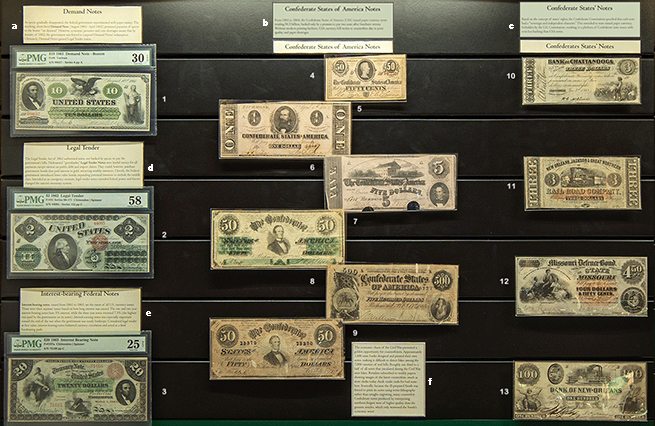
INTRODUCTION
The Civil War (1861-1865) was a defining experience for America. Financing war is always problematic for governments and causes huge economic challenges – doubly so in a civil war. The Federal and Confederate governments had to raise vast funds for the armies fighting the war through paper money and bonds. It is estimated that the Union spent $5.2 billion. Over four years, American money was stressed under pressure until, like the nation, it emerged profoundly changed. From a laissez fare system of federal specie and private bank notes, America turned to a federal monetary system backed by gold and silver, but built on paper.
Click on the items in the case image below for an enhanced view
|
AUDIO COMPANION
|
The Confederate States of America (CSA) had to build a government from scratch. Ironically, the CSA was handicapped by the very reason it existed: states’ rights! Confederate states would not allow direct taxation by the central government, but collected taxes directly before giving them to the CSA. Most southern wealth consisted of land and slaves, not cash. Southern bonds had to be purchased with hard currency; however, all available silver and gold was needed for military supplies, forcing the South to rely on unbacked paper money. The Confederacy issued $1.5 billion in currency with only a promise-to-pay in specie two years after victory. Predictably, by 1862 the notes depreciated before the ink was dry. Hyperinflation reached 9,000% by war’s end!
The Federal government levied new taxes, limiting wartime inflation to only 80%. The North entered the war with an established Treasury and a well-developed banking and industrial sector. The pre-war Federal government relied on tariffs, totaling $75 million annually. With the war costing $2 million per day, the Union introduced a new multi-tiered approach. Salmon P. Chase, Secretary of the Treasury, developed a self-reinforcing system of bonds and notes. Government bonds paid interest in gold, and for the first time, were purchasable with unbacked Legal Tender Notes. Simultaneously attracting new buyers and buoying the value of the notes, the plan resulted in the nation’s first permanent federal paper currency, which, along with America’s first income tax, paid for the war.
